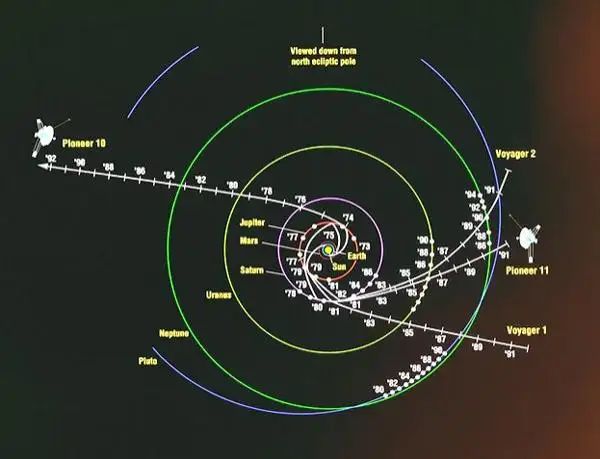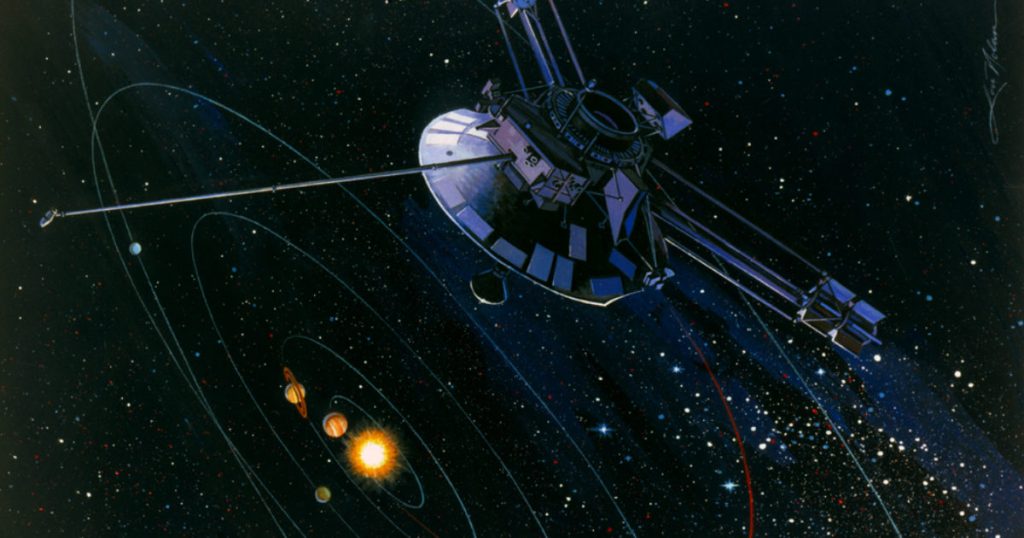Deep-Space Probes Behaving Strangely — What Happened to Pioneer 10 and 11?
The vastness of space hides many secrets — some we expect, and some catch us completely off guard. Among the most fascinating space mysteries of the 20th century is the Pioneer Anomaly, a strange and unexpected deviation in the trajectories of NASA’s Pioneer 10 and Pioneer 11 spacecraft.
At spaceyv, we are always drawn to space phenomena that challenge our understanding of physics and the known universe. The Pioneer Anomaly is a perfect example of how even our most advanced technology can encounter the unexplained in the deep void of space.
This is the story of two brave spacecraft sent to explore the Solar System — and the cosmic mystery they left behind.

What Was the Pioneer Mission?
Before diving into the anomaly, it’s essential to understand the mission itself.
Pioneer 10
-
Launched: March 2, 1972
-
Mission: First spacecraft to travel through the asteroid belt and make direct observations of Jupiter.
Pioneer 11
-
Launched: April 6, 1973
-
Mission: Flew past Jupiter and Saturn, collecting valuable data about their atmospheres, rings, and magnetospheres.
Both probes were powered by radioisotope thermoelectric generators (RTGs) and equipped with instruments to study cosmic rays, solar wind, and the environment of deep space. After their planetary missions, they continued their journey out of the Solar System, becoming some of humanity’s earliest interstellar travelers.
The Pioneer Anomaly — The Mystery Begins
What is the Pioneer Anomaly?
In the 1980s and 1990s, scientists analyzing data from the Pioneer spacecraft noticed something strange. Both Pioneer 10 and Pioneer 11 were experiencing a tiny but measurable acceleration toward the Sun — an unexpected force that slowed their journey slightly compared to what standard physics predicted.
How Big Was the Effect?
The force was incredibly small — about
(8.74 ± 1.33) × 10⁻¹⁰ m/s² —
but over millions of kilometers, even a tiny acceleration adds up.
This anomaly was completely unexplained by gravitational forces from the Sun or planets, solar radiation pressure, or other known effects in space.

Why Was It So Mysterious?
The Pioneer Anomaly baffled scientists for decades because:
-
It appeared constant over time.
-
It affected both Pioneer 10 and 11 equally.
-
It couldn’t be explained by basic physics models or spacecraft design flaws.
If the anomaly had been random or inconsistent, it might have been dismissed as a software or data error. But its consistency made it scientifically significant — some researchers even speculated that it could hint at new physics.
The Theories Behind the Pioneer Anomaly
Several hypotheses emerged to explain the Pioneer Anomaly:
1. Heat Emission from the Spacecraft (Thermal Recoil Force)
One of the leading theories is that the spacecraft’s RTGs emitted heat unevenly, causing a slight recoil effect that pushed the spacecraft backward.
2. Leaking Propellant
Some thought small leaks of gas from propulsion systems might account for the anomaly, though this was largely ruled out due to fuel monitoring.
3. Gravitational Effects or Modified Newtonian Dynamics
A more speculative idea was that the anomaly could point to flaws in our understanding of gravity at large distances — perhaps requiring adjustments to Newton’s laws or General Relativity.
4. Dark Matter or Exotic Physics
Some researchers wondered whether the anomaly hinted at exotic dark matter distributions in the Solar System or unknown physical forces acting on objects in deep space.
Has the Pioneer Anomaly Been Solved?
The Current Consensus
In 2012, a comprehensive analysis led by Slava Turyshev (NASA Jet Propulsion Laboratory) and his team suggested that thermal recoil was the most likely explanation for the Pioneer Anomaly.
They used detailed modeling of the spacecraft’s heat emissions, including reflections off various parts of the structure, and concluded that the tiny force from heat radiation could account for most — if not all — of the observed anomaly.
However, some debate still exists in the scientific community about whether this fully explains the effect or if other factors remain undiscovered.

Why Does the Pioneer Anomaly Matter?
At spaceyv, we believe the Pioneer Anomaly is a powerful reminder of why space exploration is so important.
This mystery:
-
Challenged assumptions about physics in deep space.
-
Forced NASA to improve spacecraft design and modeling techniques.
-
Sparked curiosity about the limits of human knowledge.
Even if the anomaly turns out to have a mundane explanation, it has already left a legacy of scientific inquiry that stretches far beyond its original mission.
The Legacy of Pioneer 10 and 11
Both spacecraft have long since gone silent — their power sources depleted and their communication systems beyond Earth’s reach.
Yet they remain as ghostly travelers in interstellar space, carrying their famous Pioneer Plaques — messages intended for any extraterrestrial intelligence that might one day encounter them.
Their story is not just about scientific discovery but about humanity’s relentless curiosity and desire to explore the unknown.
Conclusion
The Pioneer Anomaly remains a testament to the fact that even our most sophisticated scientific endeavors can lead to mysteries. For decades, this tiny unexplained force captured the imagination of scientists and space enthusiasts alike.
At spaceyv, we believe that space is far from being fully understood — and the Pioneer Anomaly reminds us that every mission can uncover more questions than answers.
The universe is still whispering its secrets — we just have to keep listening.
References
Anderson, J.D., Laing, P.A., Lau, E.L., Liu, A.S., Nieto, M.M., Turyshev, S.G. (2002). “Study of the Anomalous Acceleration of Pioneer 10 and 11.” Physical Review D, 65(8).
Turyshev, S.G., Toth, V.T., Kinsella, G., Lee, S.C., Lok, S.M., Ellis, J. (2012). “Support for the Thermal Origin of the Pioneer Anomaly.” Physical Review Letters, 108(24).
NASA Jet Propulsion Laboratory. “Pioneer Anomaly Solved?” (2012).
https://www.jpl.nasa.gov/news/nasas-pioneer-anomaly-mystery-appears-solved
Nieto, M.M., & Anderson, J.D. (2005). “Search for a Solution of the Pioneer Anomaly.” Contemporary Physics, 46(2).



